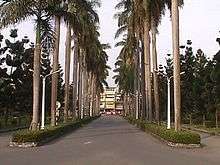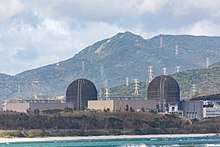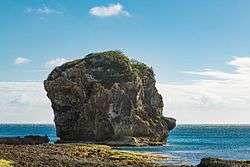Pingtung County
Pingtung County[2] is a county in Southern Taiwan region. It has a warm tropical monsoon climate and is known for its agriculture and tourism. In recent years, it has promoted specialties such as tuna and wax apples. Kenting National Park, Taiwan's oldest and largest national park, is located in the county. The county seat is Pingtung City.
Pingtung County 屏東縣 Ping tung County | |
|---|---|
 | |
 Flag  Logo | |
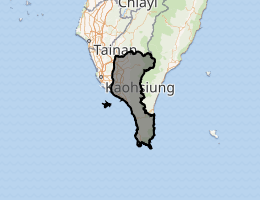
| |
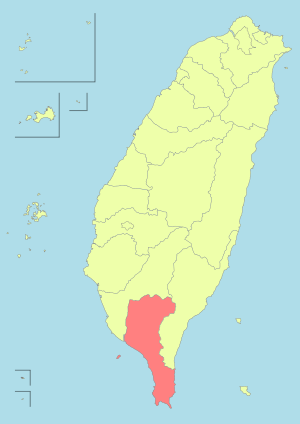 Pingtung County in Taiwan | |
| Coordinates: 22°40′31.78″N 120°29′29.09″E | |
| Country | |
| Region | Southern Taiwan |
| Seat | Pingtung City |
| Largest city | Pingtung City |
| Boroughs | 1 cities, 32 (3 urban, 29 rural) townships |
| Government | |
| • County Magistrate | Pan Men-an (DPP) |
| Area | |
| • Total | 2,775.6003 km2 (1,071.6653 sq mi) |
| Area rank | 5 of 22 |
| Population (2016)[1] | |
| • Total | 839,001 |
| • Rank | 10 of 22 |
| • Density | 300/km2 (780/sq mi) |
| Time zone | UTC+8 (National Standard Time) |
| ISO 3166 code | TW-PIF |
| Website | www.pthg.gov.tw |
| Symbols | |
| Flower | Hairy Bougainvillea (Bougainvillea brasiliensis) |
| Tree | Coconut tree |
| Pingtung County | |||||||||||||||||||||||||||||||
|---|---|---|---|---|---|---|---|---|---|---|---|---|---|---|---|---|---|---|---|---|---|---|---|---|---|---|---|---|---|---|---|
| Traditional Chinese | 屏東縣 | ||||||||||||||||||||||||||||||
| Simplified Chinese | 屏东县 | ||||||||||||||||||||||||||||||
| |||||||||||||||||||||||||||||||
Name
The name Pingtung means "east of Half-Screen Mountain", referring to a former nearby mountain known as Half-Screen Mountain (Chinese: 半屏山; Pe̍h-ōe-jī: Pòaⁿ-pêng-soaⁿ).
History
Early history
Aboriginal inhabitants of Liuqiu Island (13 km [8 mi] southwest of Taiwan, and now part of Pingtung County) killed Dutch sailors on two occasions. In response, in the spring of 1636, Dutch sailors carried out a punitive campaign that became known as the Lamey Island Massacre.
Modern-day Pingtung County and Kaohsiung City were part of Banlian-chiu (萬年州; Bān-liân-chiu) during the Kingdom of Tungning (1661–1683) and Fongshan Prefecture (鳳山縣; Hōng-soaⁿ-koān) during Qing dynasty rule (1683–1895).
Until the seventeenth century, this area of Taiwan was a place of exile for Chinese criminals and the occasional landing point for international mariners. Only the settlements near present-day Checheng Township existed. In 1664, the Hakka settlers arrived from mainland China and farmed under a homesteading system introduced by Zheng Jing.
Pingtung City, the biggest city in Pingtung County, also known as "A-Kau" (阿猴; A-kâu, English: the forest), was the home of Taiwanese Plains Aborigines.
In 1684, settlers from China's southern Fujian region created the first Han Chinese villages near Pingtung. By 1734, most of the Pingtung Plain was cultivated, and Pingtung was expanded in 1764. In 1836, the government and locals worked together to build the city's four walls (the North Gate, the East Gate, the West Gate, and the South gate), and the roads were completed.
In March 1867, fourteen American sailors were killed near Kenting by local aborigines in the Rover incident, which lead to the failed American Formosa Expedition three months later. In 1871, local aborigines killed 54 sailors from Ryukyu in the Mudan Incident. The Japanese carried out a punitive campaign against the local aborigines in the 1874 Japanese invasion of Taiwan.
Japanese rule
Under Japanese rule (1895–1945), Hōzan Subprefecture (Japanese: 鳳山支廳) was initially under Tainan Ken (臺南縣), but political divisions frequently changed between 1895 and 1901. In 1901, Akō Chō (阿猴廳) was established. In 1909, the name changed to Akō Chō (阿緱廳). In 1920, the name was changed to Heitō City (屏東市) and was under Takao Prefecture administration, which consisted of modern-day Pingtung County and Kaohsiung.
Post-war
Following the handover of Taiwan from Japan to the Republic of China on 25 October 1945, the area of present-day Pingtung County was incorporated into Kaohsiung County on 25 December 1945. On 16 August 1950, Pingtung County was established after being separated from Kaohsiung County. On 1 December 1951, Pingtung City was downgraded from provincial city to county-controlled city and county seat of Pingtung County.
Pingtung was the site of a 7.1 magnitude earthquake on 26 December 2006. In 2009, due to Typhoon Morakot, Pingtung received over 2,500 millimetres (98 in) of rainfall, breaking records for any place in Taiwan struck by a single typhoon.
Geography
With a land area of over 2,775 km2 (1,071 sq mi), Pingtung is the fifth-largest county in Taiwan, and the second-largest of Southern Taiwan after Kaohsiung City. Geographically, it borders Kaohsiung City to the north, Taitung County to the east, the Taiwan Strait to the west and the Bashi Channel to the south. Islands administered by the county include Hsiao Liuchiu (Lamay Islet; 琉球嶼) and Qixingyan (Seven Star Reefs; 七星岩).
Climate
Located in the southernmost part of Taiwan, Pingtung County is known for one of the warmest climates within the country. It has a tropical monsoon climate bordering on a tropical wet and dry climate (Köppen climate classifications: Am bordering on Aw). The climate differs across the large county due to its varying geography.
Northern Pingtung, where Pingtung City is located, is characterized by high daytime temperatures year-round with average daytime highs of 30–40 °C (86–104 °F) from April to November, and 25–28 °C (77–82 °F) from December to March. The lowest nighttime temperatures are around 16 °C (61 °F), due to distance from the sea.
Central Pingtung, such as the coastal Fangliao Township, has a lower daytime temperatures and warmer nights due to the regulating effect of the ocean, which is especially noticeable during winter.
The mildest climate of Pingtung is at its southern tip, the Hengchun Peninsula, which is nearly surrounded by the Pacific Ocean. Daily highs reach 29–32 °C (84–90 °F) during summer and 23–26 °C (73–79 °F) during winter. Nighttime temperatures remain warm throughout the year with lows of around 25 °C (77 °F) during summer and 19 °C (66 °F) during the winter.
| Climate data for Pingtung County (Hengchun Township) | |||||||||||||
|---|---|---|---|---|---|---|---|---|---|---|---|---|---|
| Month | Jan | Feb | Mar | Apr | May | Jun | Jul | Aug | Sep | Oct | Nov | Dec | Year |
| Record high °C (°F) | 32.2 (90.0) |
32.4 (90.3) |
34.2 (93.6) |
35.8 (96.4) |
37.1 (98.8) |
36.4 (97.5) |
35.6 (96.1) |
35.3 (95.5) |
36.0 (96.8) |
34.1 (93.4) |
33.8 (92.8) |
32.5 (90.5) |
37.1 (98.8) |
| Average high °C (°F) | 25.1 (77.2) |
26.6 (79.9) |
28.3 (82.9) |
29.6 (85.3) |
31.0 (87.8) |
31.5 (88.7) |
32.0 (89.6) |
31.7 (89.1) |
31.2 (88.2) |
29.8 (85.6) |
27.7 (81.9) |
26.2 (79.2) |
29.2 (84.6) |
| Daily mean °C (°F) | 21.2 (70.2) |
21.7 (71.1) |
23.3 (73.9) |
25.4 (77.7) |
27.1 (80.8) |
28.1 (82.6) |
28.5 (83.3) |
28.2 (82.8) |
27.6 (81.7) |
26.4 (79.5) |
24.5 (76.1) |
22.0 (71.6) |
25.3 (77.6) |
| Average low °C (°F) | 18.3 (64.9) |
19.0 (66.2) |
20.3 (68.5) |
22.5 (72.5) |
24.2 (75.6) |
25.5 (77.9) |
25.7 (78.3) |
25.4 (77.7) |
24.9 (76.8) |
24.0 (75.2) |
22.2 (72.0) |
19.6 (67.3) |
22.6 (72.7) |
| Record low °C (°F) | 8.4 (47.1) |
9.8 (49.6) |
10.4 (50.7) |
14.7 (58.5) |
17.1 (62.8) |
18.6 (65.5) |
19.4 (66.9) |
19.5 (67.1) |
18.7 (65.7) |
16.0 (60.8) |
12.7 (54.9) |
9.5 (49.1) |
8.4 (47.1) |
| Average rainfall mm (inches) | 25.7 (1.01) |
27.7 (1.09) |
19.9 (0.78) |
43.5 (1.71) |
163.9 (6.45) |
371.3 (14.62) |
396.3 (15.60) |
475.2 (18.71) |
288.3 (11.35) |
141.8 (5.58) |
43.2 (1.70) |
20.6 (0.81) |
2,017.4 (79.43) |
| Average rainy days (≥ 0.1 mm) | 8.0 | 6.8 | 4.8 | 6.3 | 11.1 | 16.9 | 16.4 | 18.9 | 15.9 | 10.8 | 7.1 | 6.1 | 129.1 |
| Average relative humidity (%) | 72.6 | 73.7 | 74.4 | 75.4 | 78.5 | 83.6 | 83.3 | 84.0 | 79.7 | 74.0 | 73.1 | 72.4 | 76.7 |
| Mean monthly sunshine hours | 168.0 | 165.1 | 199.7 | 192.6 | 193.9 | 183.6 | 221.0 | 195.5 | 177.2 | 198.1 | 177.7 | 161.4 | 2,233.8 |
| Source: Central Weather Bureau (normals 1994–2013) (extremes 1897–present)[3][4] | |||||||||||||
Government
Administrative divisions
| Pingtung County Administrative Divisions |
Pingtung County is divided into 1 city, 3 urban townships, 21 rural townships, and 8 indigenous mountain townships. Pingtung County has the largest number of rural townships and mountain indigenous townships among the counties of Taiwan.
Colors indicate the statutory language status of Hakka and Formosan languages in the respective subdivisions.
Politics
Pingtung City is the county seat of Pingtung County which houses the Pingtung County Government and Pingtung County Council. The county head is Magistrate Pan Men-an of the Democratic Progressive Party. Pingtung County elected three Democratic Progressive Party legislators to the Legislative Yuan during the 2016 legislative election.[5][6][7]
Demographics
| Year | Pop. | ±% |
|---|---|---|
| 1985 | 901,981 | — |
| 1990 | 893,282 | −1.0% |
| 1995 | 911,843 | +2.1% |
| 2000 | 907,590 | −0.5% |
| 2005 | 893,544 | −1.5% |
| 2010 | 873,509 | −2.2% |
| 2015 | 841,253 | −3.7% |
| 2016 | 835,792 | −0.6% |
| 2019 | 817,803 | −2.2% |
| Source:"Populations by city and country in Taiwan". Ministry of the Interior Population Census. | ||
Pingtung is home to the indigenous Rukai and Paiwan tribes, which makes up 7% of the population.[8] As of December 2016, the total population of Pingtung County was 835,792. The county has been experiencing population decline for 15 consecutive years due to emigration to other cities.[9][10]
Economy
The agriculture and fishing industries dominate the county's economy. In recent years, the county has also promoted the tourism sector, which constituted 30% of Taiwan's tourism industry in 2015.[11]
In February 2014, the county government announced a plan to develop an industrial center that consists of a service center, workshop, and performance venue. The aim is to promote the development of industries that leverage the unique cultural attributes of the Linali tribe.[12] On 22 September 2015, the National Development Council revealed a three-year large-scale development plan to boost the economy of the county by transforming Dapeng Bay, Donggang Township, and Lamay Island into a fishery, recreational, and tourism hub.[13]
Education
Universities and colleges
High schools
- Pingtung Senior High School
- Pingtung Girl's Senior High School
- Da-Tong Senior High School
- Chao-Chou Senior High School
Energy
Pingtung County houses Taiwan's third nuclear power plant, the Maanshan Nuclear Power Plant. The power plant is located in Hengchun Township. It is Taiwan's second-largest nuclear power plant in terms of its capacity at 2 × 890 MW.
Transportation
Rail
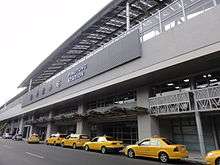
The Pingtung Line and South-Link Line of the Taiwan Railways Administration cross Pingtung County. These lines service Central Signal, Chaozhou, Donghai, Fangliao, Fangshan, Fangye Signal, Guilai, Jiadong, Jialu, Kanding, Linbian, Linluo, Liukuaicuo, Nanzhou, Neishi, Pingtung, Xishi, Zhen'an and Zhutian Station. The Pingtung Line links Pingtung County with Kaohsiung City, while the South-Link Line links Pingtung County with Taitung County.
Ferries
Ferry service operates between Donggang Township and Baisha Port and Dafu Port on the offshore Lamay Island.
Tourist attractions

- Ahou City Gate
- An-Nur Tongkang Mosque
- Black Dwarf Cave
- Black Pearl – Top Quality Wax Apple
- Checheng Fuan Temple
- Danlin Suspension Bridge
- Eluanbi Lighthouse
- Fangliao F3 Art Venue[14][15]
- Fangshan Post Office
- Hengchun Chuhuo Natural Fire
- Indigenous Culture Hall
- Jialeshuei
- Jiaruipu Temple
- Kaoping Iron Railway Bridge
- Kaoping Riverfront Park
- Kapok Trees
- Kenting National Park
- Kentington Resort
- Kuan Hai Shan Academy
- Landscape of Manjhou
- Linben Riverfront Park
- Linhousilin Forest Park
- Liudui Hakka Cultural Park
- Loacijia Slate Houses
- Longkeng Conservation Area
- Longluan Lake
- Longpan Park
- Mobitou
- Mudan Dam
- Museum of Traditional Theater
- National Museum of Marine Biology and Aquarium
- Old House of Siiao Family
- Penbay International Circuit
- Pingtung Art Museum
- Pingtung Hakka Cultural Museum
- Shuangliu Forest Recreation Area
- Sinpi Jian-gong Water Park
- South Bay
- Taipower Exhibit Center in Southern Taiwan
- Taiwan Indigenous Peoples Cultural Park
- Three Mountains King Temple
- Tungkang Tunglung Temple
- Wanchin Church
See also
- List of magistrates of Pingtung County
- List of Taiwanese superlatives
References
- 105年05月屏東縣人口統計表. www.pthg.gov.tw (in Chinese). Archived from the original on 8 November 2018. Retrieved 6 June 2016.
- Mandarin pinyin: Píngdōng Xiàn, Wade-Giles: Pʻing²-tung¹ Hsien⁴; Hokkien POJ: Pîn-tong-koān; Hakka PFS: Phìn-tûng-yan; Paiwan: Akaw/Qakaw
- "Climate". Central Weather Bureau. Archived from the original on 12 June 2017. Retrieved 24 August 2014.
- "Climate". Central Weather Bureau. Archived from the original on 26 March 2014.
- "2016 The 14th Presidential and Vice Presidential Election and The 9th Legislator Election". Archived from the original on 4 March 2016. Retrieved 17 January 2016.
- "2016 The 14th Presidential and Vice Presidential Election and The 9th Legislator Election". Archived from the original on 4 March 2016. Retrieved 17 January 2016.
- "2016 The 14th Presidential and Vice Presidential Election and The 9th Legislator Election". Archived from the original on 4 March 2016. Retrieved 17 January 2016.
- "PINGTUNG County Government". Archived from the original on 3 February 2016. Retrieved 6 January 2016.
- Hou, Cheng-hsu; Chang, Tsun-wei; Chung, Jack (11 January 2017). "Pingtung population falls for 15th consecutive year". Taipei Times. Archived from the original on 11 January 2017. Retrieved 11 January 2017.
- "Pingtung population falls for 14th consecutive year". Archived from the original on 3 March 2016. Retrieved 24 February 2016.
- "Archived copy". Archived from the original on 28 August 2016. Retrieved 20 July 2016.CS1 maint: archived copy as title (link)
- "Archived copy". Archived from the original on 14 February 2015. Retrieved 14 February 2015.CS1 maint: archived copy as title (link)
- "Archived copy". Archived from the original on 16 September 2016. Retrieved 20 July 2016.CS1 maint: archived copy as title (link)
- Located just a few minutes'walk from Fangliao train station, the art village stretches around 3,000 square meters which provides artists in residence plenty of room to work and live. Converted from old dormitories that once belonged to the Taiwan Railway Administration, the art village has been part of the Art Network of Railway Warehouses run by the Council for Cultural Affairs since 2002.
- "Art at the Crossroads: F3's Undetermined Future in Fangliao", by Eva Tang, 12 February 2009, Taiwan Culture Portal http://www.culture.tw/index.php?option=com_content&task=view&id=1114&Itemid=157 Archived 30 October 2010 at the Wayback Machine
External links
| Wikimedia Commons has media related to Pingtung County. |
- Pingtung County Government
- i-Pingtung - Tourist Service

_location_map.svg.png)
